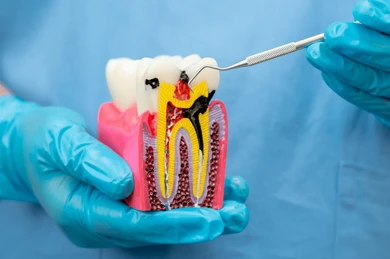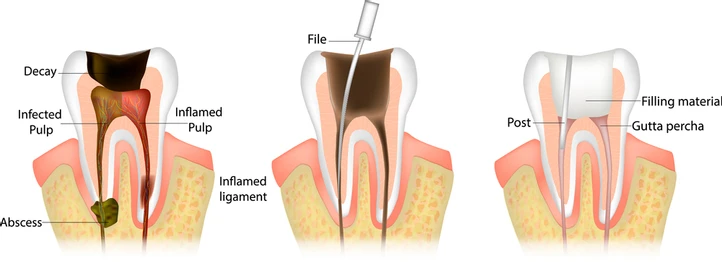Root Canal Treatment in Ahmedgarh
Are you experiencing persistent tooth pain, sensitivity, or swelling in your gums? These symptoms can be more than just cavities—they might signal an infected tooth nerve that needs immediate attention. In such cases, a root canal treatment could be your best option to avoid extraction and preserve your natural smile.
“A root canal isn’t something to fear anymore. With advanced technology and modern anesthesia, the procedure is now as comfortable as a regular filling,”
says Dr. Rajnish Jindal, a leading dentist in Ahmedgarh.
At Superfine Dental Care & Implant Centre, Dr. Rajnish Jindal MDS Endodontics(Root Canal Treatment specialist) and Dr. Megha Jindal bring over 14 years of combined clinical experience to every treatment they execute. Recognized for their ethical practice and precision-based care, they have performed more than 10,000 root canal treatments in Ahmedgarh, prioritizing patient comfort, long-term results, and overall oral health.
Confused about what a root canal involves? Let’s break it down into simple terms to ease your concerns.
What Is Root Canal Treatment?
A root canal treatment is a dental procedure aimed at saving a severely damaged or infected tooth. The process entails the removal of infected or inflamed pulp (the soft tissue inside the tooth). After the pulp is removed, the dentist cleans and disinfects the root canals before sealing the space with a biocompatible material.
Contrary to popular belief, the procedure is not painful—especially when performed with modern techniques and local anesthesia.
This treatment becomes necessary when deep decay, repeated dental work, or trauma causes bacteria to reach the tooth’s pulp. Without intervention, the infection can spread, leading to abscesses, severe pain, or even tooth loss. By opting for a root canal treatment, you can preserve your natural tooth structure and avoid the need for extraction or implants.
Still unsure whether to save your tooth or remove it entirely? Here’s why a root canal is often the smarter, long-term choice.
Why Choose Root Canal Over Extraction?
Preserves Your Natural Tooth:
Nothing functions or feels like your original tooth. A root canal allows you to keep
Maintains Jawbone Health:
Tooth loss can lead to bone shrinkage in the jaw. Keeping your tooth helps prevent this.
Protects Adjacent Teeth:
Extraction may cause nearby teeth to shift or become unstable over time.
Better Chewing Efficiency:
A natural tooth supports proper chewing and digestion, unlike a missing or artificial one.
Cost-Effective in the Long Run:
While extraction may seem cheaper initially, the cost of replacements, such as bridges or implants, can add up.
Faster and Less Invasive Recovery:
Root canal treatment is less traumatic to the mouth compared to surgical extractions.
No Gaps, No Embarrassment:
Retain your full smile without needing prosthetics to fill in missing spaces.
Do your symptoms point to a root canal? Here are some warning signs you shouldn’t ignore.
Signs You May Need a Root Canal
Persistent Tooth Pain:
Continuous or recurring pain, especially while chewing or applying pressure, is often a key indicator.
Sensitivity to Hot and Cold:
Sharp pain that lingers after consuming hot drinks or ice-cold foods may suggest nerve damage.
Swollen or Tender Gums:
Swelling around a specific tooth or gum tenderness can indicate an underlying infection.
Darkening of the Tooth:
Discoloration of a tooth may mean the pulp is damaged or dying.
Pimple or Abscess on Gums:
A pus-filled bump near the tooth could signal a deep infection or abscess.
Cracked or Chipped Tooth:
Trauma or cracks can expose the pulp to bacteria, requiring root canal intervention.
Pain When Touching the Tooth:
If even a light tap causes discomfort, the tooth’s inner structure may be compromised.
Our Advanced Root Canal Procedure
At Superfine Dental Care, we utilize modern equipment and precision methods to offer a painless and hassle-free root canal treatment in Ahmedgarh.
Take a step-by-step look at our advanced process:
Digital X-ray & Diagnosis:
We begin with a high-resolution digital scan to accurately diagnose the infection and design a tailored treatment.
Local Anesthesia for Comfort:
We numb the area entirely so you don’t feel anything during the procedure.
Pulp Removal & Canal Cleaning:
With rotary endodontic instruments, we remove the infected pulp and clean the canals extensively.
Disinfection:
Advanced irrigation solutions are used to eliminate bacteria and prevent reinfection.
Filling & Sealing:
Once cleaned, the canals are filled with a biocompatible material (usually gutta-percha) and sealed to prevent leakage.
Tooth Restoration:
A crown may be placed in a follow-up visit to restore the tooth’s shape, strength, and function.
Benefits of Root Canal Treatment at Superfine Dental Care
Here’s what makes us a preferred choice for root canal treatment in Ahmedgarh:
Gold-Medallist Expertise:
Led by Dr. Rajnish Jindal MDS Endodontics (Root Canal Treatment Specialist)—experienced specialist in conservative dentistry and orthodontics.
One-Visit Root Canal Option:
Save time with advanced rotary endodontics that enable single-visit treatments in many cases.
Painless Root Canal Procedure:
We utilize the latest anesthesia and techniques to ensure a stress-free experience.
Microscopic Precision:
Enhanced visibility ensures more thorough cleaning and sealing of canals.
In-House Digital Imaging:
Accurate, low-radiation diagnostics for faster and safer treatment planning.
Ethical, Patient-First Approach:
Transparent communication, zero over-treatment, and personalized care.
What happens after the procedure? Here are some root canal recovery tips to help make the healing process smooth.
Post-Treatment Care and Recovery
Proper aftercare can significantly impact your comfort and long-term tooth health.
Avoid Chewing on the Treated Side:
Allow your tooth to settle by chewing on the other side until a permanent crown is fitted.
Take Medications as Prescribed:
Finish the entire course of antibiotics or pain medication if administered to avoid reinfection and reduce pain.
Maintain Oral Hygiene:
Brush and floss as usual but gently around the treated tooth to prevent irritation.
Expect Mild Discomfort:
Some discomfort is to be expected for a couple of days—it generally resolves itself or with medication.
Follow-Up for Crown Placement:
A permanent crown helps protect the tooth and restore full function, so don’t skip this step.
Watch for Warning Signs:
If you experience swelling, fever, or severe pain, contact the clinic immediately.
Frequently Asked Questions
Is root canal treatment painful?
Modern root canal treatments are virtually painless. With local anesthesia and advanced tools, the procedure feels similar to a routine dental filling.
How long does a root canal procedure take?
Depending on the tooth’s condition, a root canal typically takes 60–90 minutes and is often completed in a single visit.
Will I need a crown after root canal treatment?
Yes, most back teeth require a crown after root canal to restore strength and prevent future damage or fractures.
Can a root canal-treated tooth get infected again?
Reinfection is rare but possible if the sealing breaks down or if proper aftercare and crown placement are delayed.
How long does a root canal-treated tooth last?
With proper care and crown placement, it can last a lifetime—just like your natural teeth.
Disclaimer: The content shared on this page is for informational purposes and not for promotional use.







